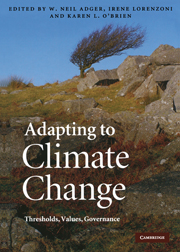Book contents
- Frontmatter
- Contents
- List of contributors
- Preface
- 1 Adaptation now
- Part I Adapting to thresholds in physical and ecological systems
- Part II The role of values and culture in adaptation
- Part III Governance, knowledge and technologies for adaptation
- 20 Whether our levers are long enough and the fulcrum strong? Exploring the soft underbelly of adaptation decisions and actions
- 21 Decentralized planning and climate adaptation: toward transparent governance
- 22 Climate adaptation, local institutions and rural livelihoods
- 23 Adaptive governance for a changing coastline: science, policy and publics in search of a sustainable future
- 24 Climate change, international cooperation and adaptation in transboundary water management
- 25 Decentralization: a window of opportunity for successful adaptation to climate change?
- 26 Adapting to climate change in Sámi reindeer herding: the nation-state as problem and solution
- 27 Limits to adaptation: analysing institutional constraints
- 28 Accessing diversification, networks and traditional resource management as adaptations to climate extremes
- 29 Governance limits to effective global financial support for adaptation
- 30 Organizational learning and governance in adaptation in urban development
- 31 Conclusions: Transforming the world
- Index
- References
23 - Adaptive governance for a changing coastline: science, policy and publics in search of a sustainable future
Published online by Cambridge University Press: 31 August 2009
- Frontmatter
- Contents
- List of contributors
- Preface
- 1 Adaptation now
- Part I Adapting to thresholds in physical and ecological systems
- Part II The role of values and culture in adaptation
- Part III Governance, knowledge and technologies for adaptation
- 20 Whether our levers are long enough and the fulcrum strong? Exploring the soft underbelly of adaptation decisions and actions
- 21 Decentralized planning and climate adaptation: toward transparent governance
- 22 Climate adaptation, local institutions and rural livelihoods
- 23 Adaptive governance for a changing coastline: science, policy and publics in search of a sustainable future
- 24 Climate change, international cooperation and adaptation in transboundary water management
- 25 Decentralization: a window of opportunity for successful adaptation to climate change?
- 26 Adapting to climate change in Sámi reindeer herding: the nation-state as problem and solution
- 27 Limits to adaptation: analysing institutional constraints
- 28 Accessing diversification, networks and traditional resource management as adaptations to climate extremes
- 29 Governance limits to effective global financial support for adaptation
- 30 Organizational learning and governance in adaptation in urban development
- 31 Conclusions: Transforming the world
- Index
- References
Summary
Introduction
The risks of coastal flooding and erosion in the UK are changing in response to the likely effects of climate change, natural isostatic readjustment and the consequences of hard coastal defence initiatives which have lead to coastal instability elsewhere. In addition to the considerable uncertainty brought about by these factors, there has been a significant, strategic shift in national coastal management policy in England away from investing in expensive ‘hard’ engineered defence, toward designing a more naturally functioning coastline.
This policy change (Defra, 2005a) has come about in light of questions being asked about the physical sustainability (and increasing cost) of a reliance on engineered defences. This means that many coastal communities of varying size in England are now facing a situation of great unease and anxiety about their future; new policy preferences for retreat and realignment mean no future guarantees of protection. Coastal governance arrangements at national to local scales have not yet adequately responded to the new strategic outlook; the national shift of priority has not been matched by any compensation package or appropriate initiatives to promote the development and delivery of associated adaptation requirements in such locations.
Drawing on Tyndall Centre research, this chapter presents an analysis of the governance setting for the management of England's changing coastline (O'Riordan et al., 2006, 2008; Milligan and O'Riordan, 2007; Milligan et al., 2009).
- Type
- Chapter
- Information
- Adapting to Climate ChangeThresholds, Values, Governance, pp. 368 - 383Publisher: Cambridge University PressPrint publication year: 2009
References
- 14
- Cited by



